Raw Milk Kefir
This week, I went on a deep internet dive to learn about the history of milk and why humans started to consume milk from animals in the first place. I certainly learned a lot.
To summarize, someone used animal milk for nutrition, and probably survival, for the first time around 10,000- 7,500 years ago… Someone most likely observed the similarities between breastfeeding human babies and baby cattle, then decided that keeping the animal to consume its milk was a more reliable nutrition source than killing the animal and eating the meat. The milk was almost always naturally fermented into what we know as buttermilk, kefir, yogurt, and cheeses.
Since there were no refrigerators, milk was stored at ambient temperature in ceramic jars or canteens made from sheep’s stomachs. These vessels (and the utters of animals) harbored microbes that always led to some kind of natural fermentation, most similar to raw milk kefir.
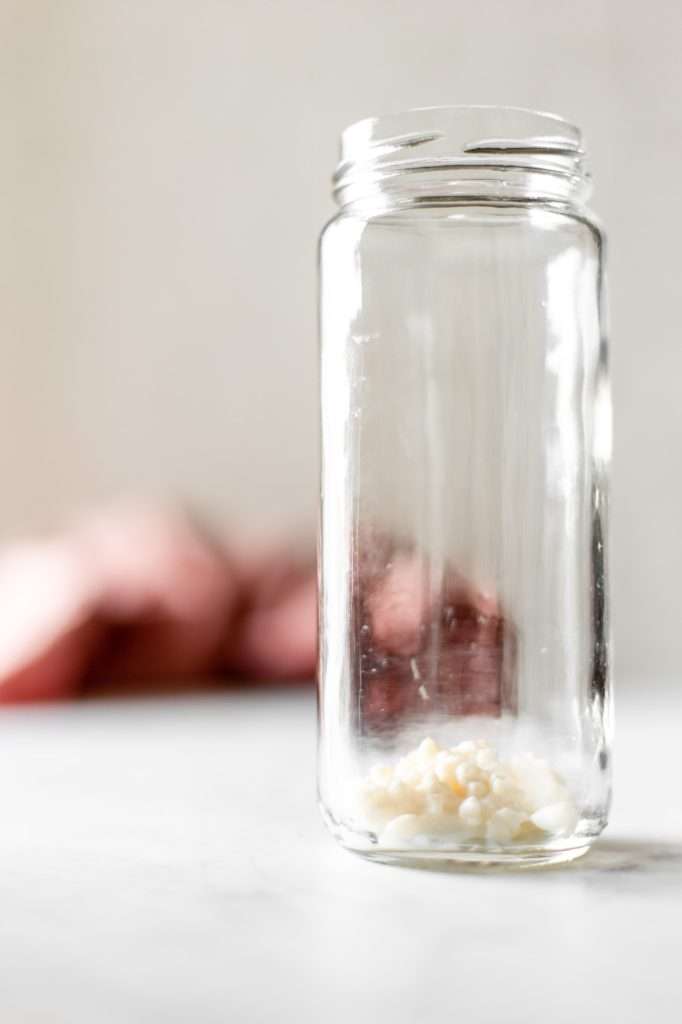
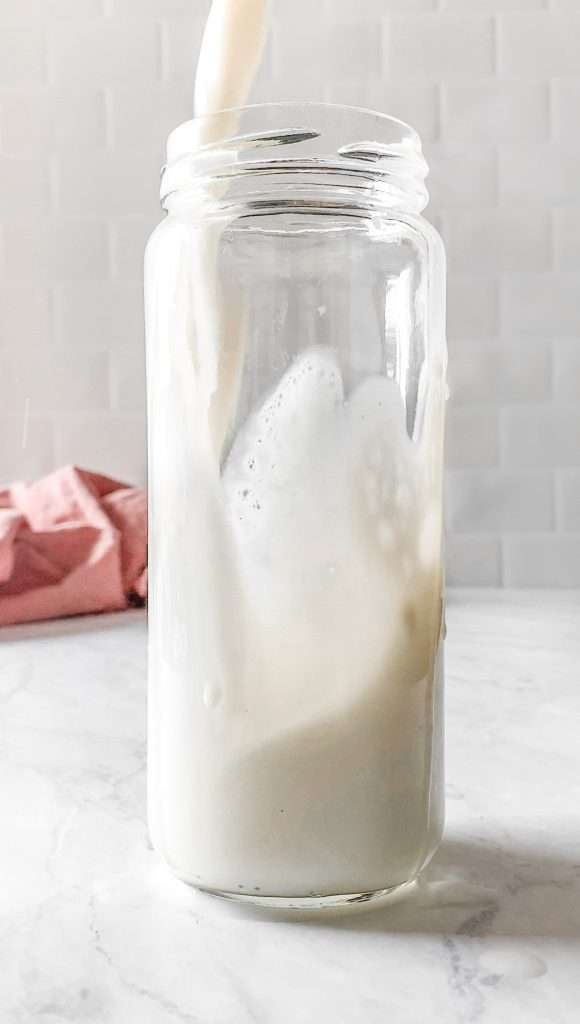
Kefir Milk Benefits
There are many benefits of milk kefir. Milk kefir is the most nutritious, easily digestible dairy product.
The primary nutrients of kefir are similar to that of the milk from which it is produced. Thus, it is high in protein, healthy fats, and calcium. The kefir fermentation process improves the nutritional value of milk by increasing the quantity, bioavailability, digestibility, and assimilability of vitamins and nutrients.
The word Kefir, derived from the Turkish word “keyif,” means “good feeling,” and I think that perfectly describes milk kefir! Kefir is known by various names in other countries including képhir, kiaphur, kefyr, knapon, kepi, and kippi.
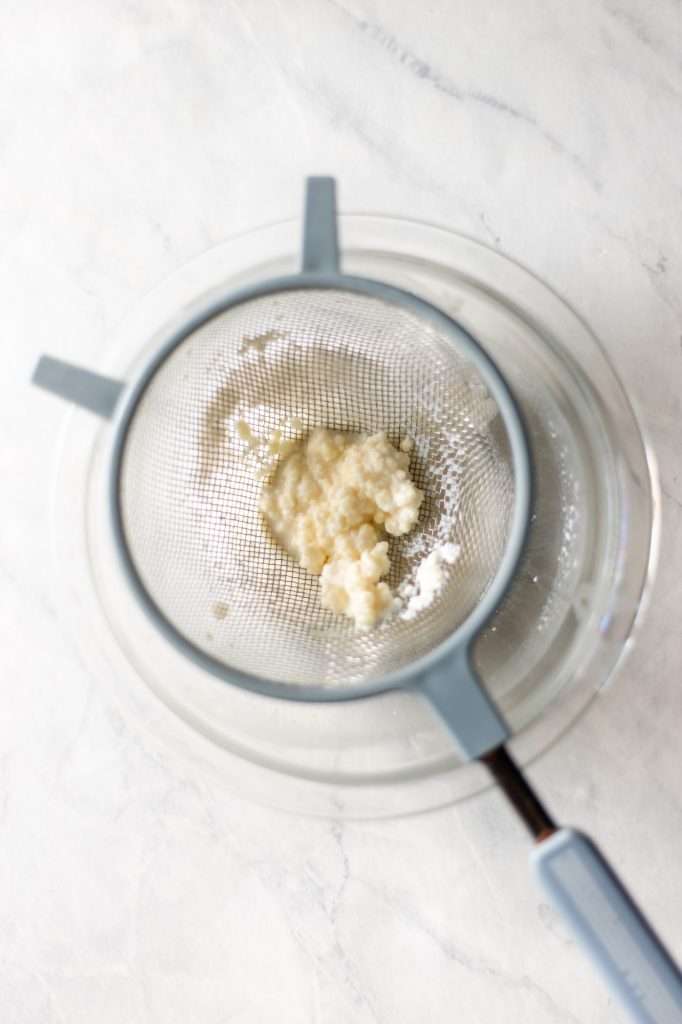
Whole Milk Kefir
After five years of not eating or drinking dairy, I’ve been trying milk kefir and eating hard-fermented cheeses! I’m very excited. I also now want a dairy cow… and Angora goats.
I gave up dairy five years ago when I was healing my eczema and, thus, my gut. So, I am ready to reintroduce high-quality home-fermented dairy into my diet.
I am making milk kefir at home using organic, non-homogenized cream top milk from Kalona Supernatural. It still includes the cream from grass-grazed cows on small Amish and Mennonite family farms in the Midwest. Until I get land and animals, this milk is a great option.
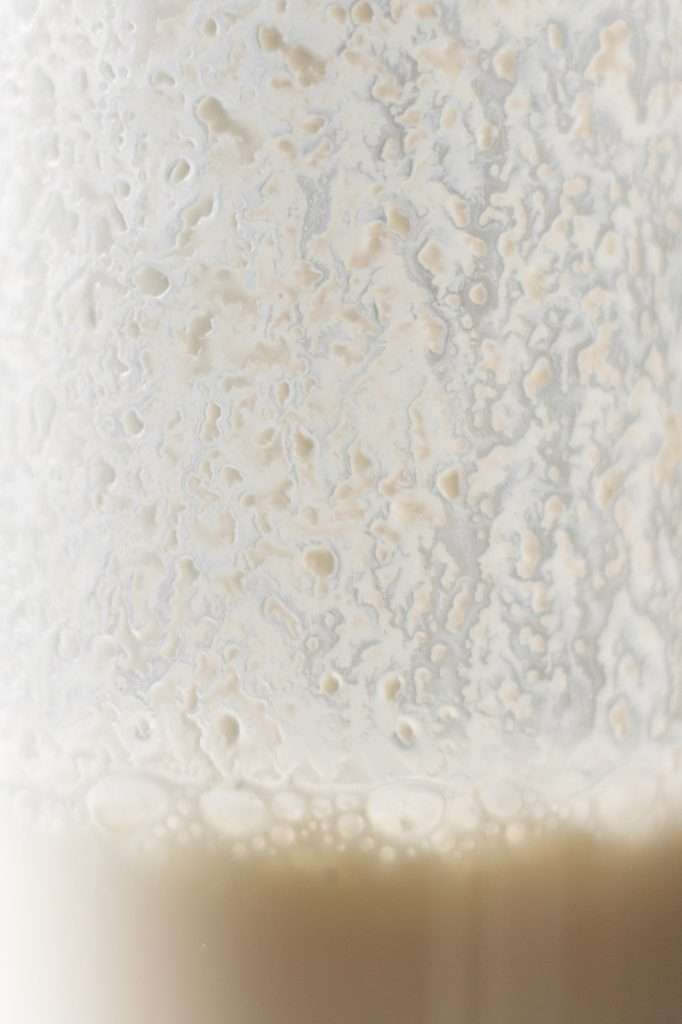
Ingredients and equipment you need for this recipe
You only need two ingredients to make milk kefir- grains and milk! You can use any animal milk you want. Goat milk kefir is quite delicious, but I usually use cow milk.
- High-quality milk, you can use cow, goat, or sheep milk
- milk kefir grains, click here for my favorite grains
- 16-ounce mason jar, thoroughly cleaned
- cloth covering and a rubber band
- mesh strainer
If you are brand new to making kefir, the easiest way to get started is with the Cultures For Health Milk Kefir kit! Click here to learn more about that.

Milk Kefir Grains
So, what kind of microbes ferment milk into kefir? Many different types of yeasts and bacteria make up the microbial communities called kefir grains, and the specific species vary depending on where they are from and the milk used to feed them.
Kefir grains consist of a species-rich and robust microbial community. Look at this chart from a published paper on Milk kefir: composition, microbial cultures, biological activities, and related products. It shows how diverse and species-rich the microbial communities in the grains can be and how microbial composition varies by region:
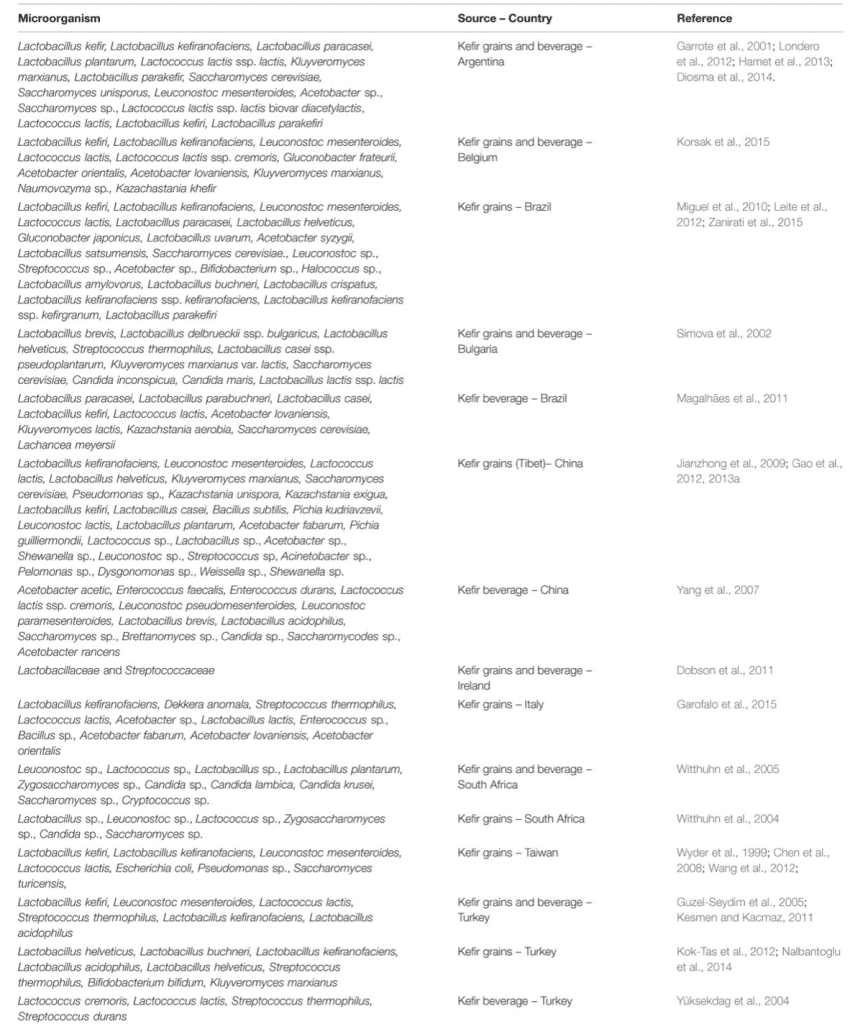
More Fermentation Recipes to Try
- How to Make Homemade Yogurt with Matcha and Vanilla (Dairy-Free)
- How to Make Yogurt in an Instant Pot
- How to Make Dairy-Free Coconut Yogurt with Mango
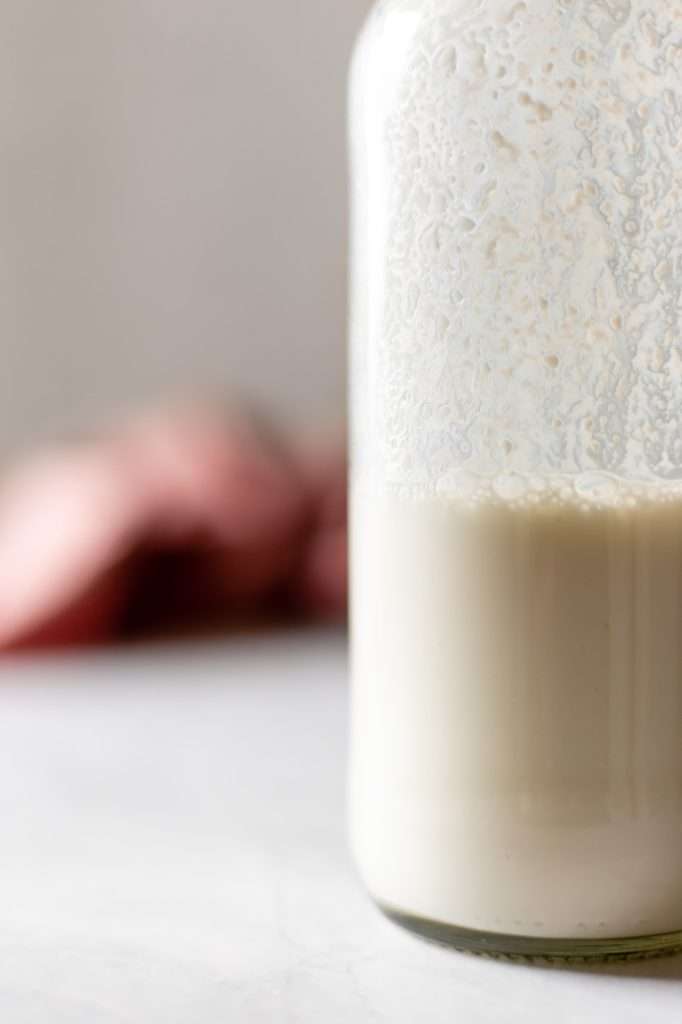

How to Easily Make Milk Kefir at Home
Are you looking for an easy fermented drink to make at home? Then milk kefir is for you! You just need milk kefir grains, organic whole milk, a glass jar, a cloth covering, and a mesh strainer. You never have to replace the starter culture for milk kefir. Once you acquire milk kefir grains, they last forever as long as you feed them fresh milk. Homemade milk kefir is an affordable source of probiotics, vitamins and nutrients.
- Prep: 10 minutes
- Total Time: 24 hours 10 minutes
Ingredients
- 16 Ounces fresh whole milk (about 500 mL)
- About 20 grams of hydrated and active milk kefir grains
Instructions
- Add the milk to a glass jar.
- Add in the milk kefir grains and stir the milk gently.
- Place a tight-weave breathable cloth lid on the jar and secure it with a rubber band.
- Allow the milk to ferment for 24-48 hours. (Aim for less time if it is warm in your house. ferment longer if it is cooler in your house)
- When the kefir is finished, you may need to give it a stir. It should be thick, pleasantly tart, you should see “rivers” on the sides of the jar after pouring.
- After fermentation, strain off the kefir grains and add them to a fresh batch of milk. Store the finished kefir in the fridge in a sealed bottle for up to a month.
Notes
- You can make kefir with fresh raw milk or pasteurized milk. Pasteurized milk will give more consistent flavor, while raw milk kefir give variation across batches and changes in your grains over time.
- To pasteurize your milk: Place a thermometer in the jar of milk. Place the jar of milk in a pot of water and allow it to get to room temperature. Slowly, on low heat, bring the pot of water to a light simmer. Bring the temperature of the milk up to 181° F (83° C). Once it reaches this temperature, remove the jar of milk from the hot water bath. Leave the thermometer in the jar, and cover with a clean towel. Allow the milk to cool down to about 110° F (43° C). Cooling can take an hour. Once cooled, remove the thermometer and proceed to step three.
- Keep the ratio of grains to milk about the same (10 grams of active grains per cup). When the grains multiply, you can remove some of them, dehydrate them at a low temp in a dehydrator, and store them in a mason jar at room temp.



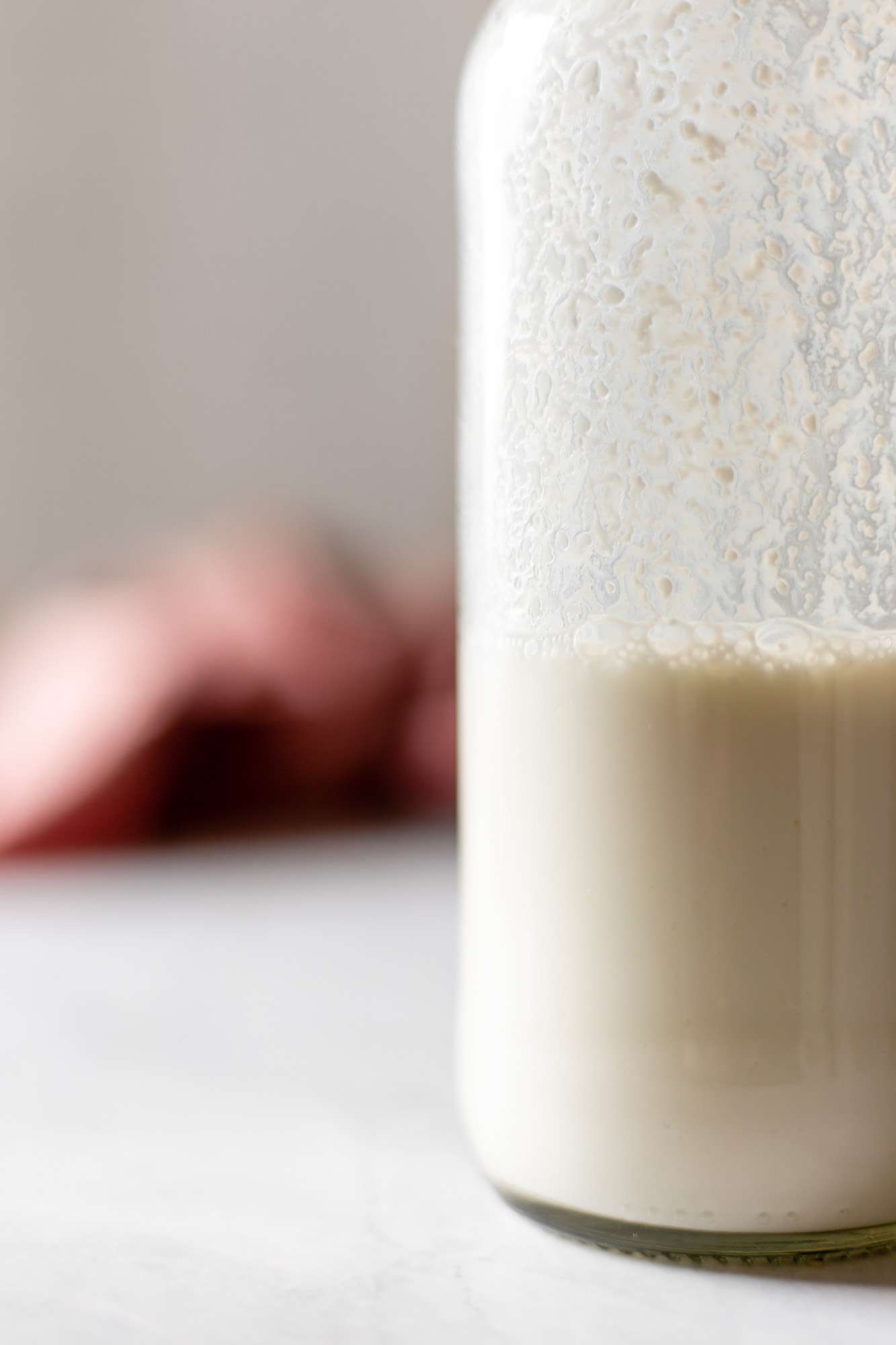












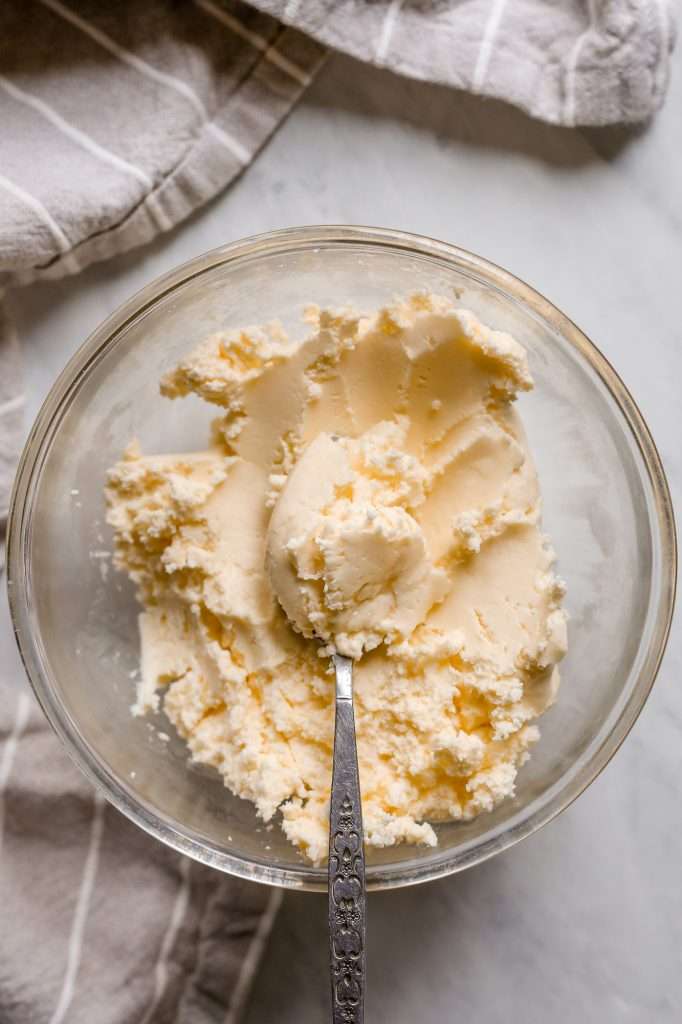

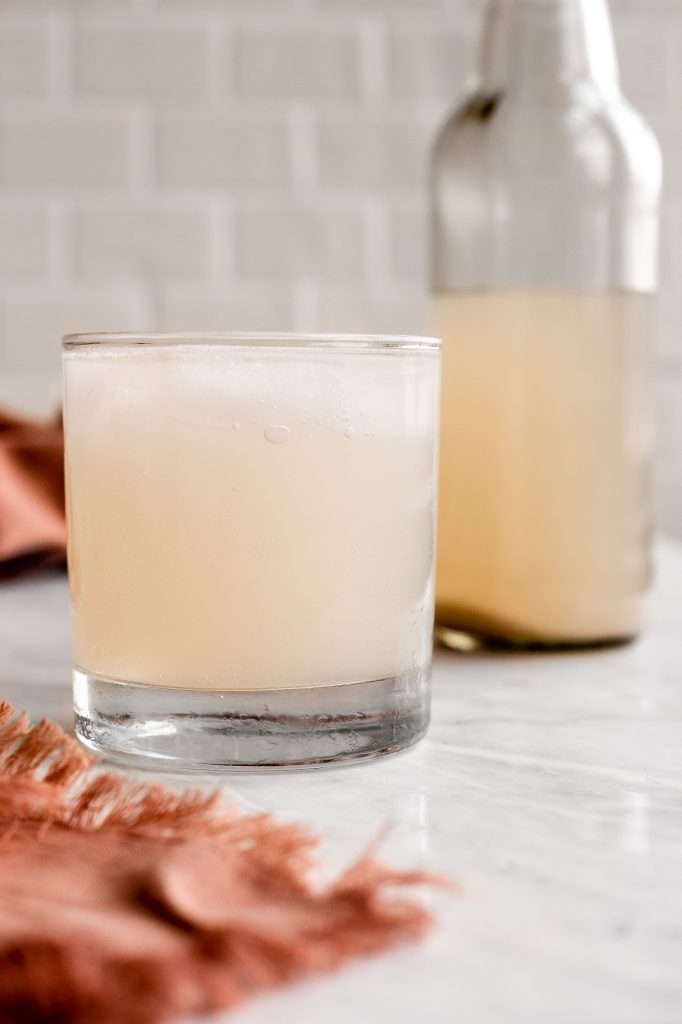

Hello Kaitlynn, thanks for the post on kefir. We are looking for milk kefir grains to make home made Amish kefir. I was wondering which of the strains of L.B would you recommend based on your research. Also, you have posted the link of Etsy seller and wanted to know how those strains compared with with some of the others like
http://www.gemcultures.com/dairy_cultures.htm
https://positivelyprobiotic.com/
if you have tried them. Thanks again.
-Bala
Hello!
I’m not familiar with any special differences between Amish kefir and regular milk kefir, other than the fact that Amish kefir is most likely made with non-homogenized milk (or raw milk). I haven’t worked with any of the grains you linked, so I cannot make a valid comparison. All grains have slightly different strains. I really like the grains I bought on Etsy. They work well and multiply often.
Hello Kaitlynn, I’d love to make my own kefir but I mostly live alone and can only drink one glass a day max. Can I make kefir every 2-3 days or does it have to be daily?
Thanks, Jane
P.S am so happy I found you on Instagram, have been making the dill pickles which are delicious and tomorrow I’m trying the lemons, thank you for all the amazing information!
Hi Kaitlynn, your dill pickles recipe has triggered a fermenting frenzy in my house and today I’m trying lemons. I would love to make my own kefir but I mostly live alone and it looks like the yield will be far too much for me. Can I leave the grains for 2-3 days before making the next batch and if so how?
Many thanks for all the information, Jane
So glad to hear this! yes, you can leave the grains in fresh milk in the refrigerator for 2-3 days before making the next batch.
That’s great thanks, I’ll give it a go!
I just have two questions on making this kefir and was hoping you could help, I’ve followed the steps but 24hrs later its not really thickened, I’m also not sure what is meant by seeing “rivers” when pouring I didn’t see anything. Do I need to let it ferment further? Also the cream from the top of the milk is still on top after fermenting, do I mix that into the kefir also?
Also when I have fermented correctly how long can I store the kefir grains in fresh milk? do they go into the fridge also? (just need to know this incase I go away, I don’t want the grains to “die”).
Any guidance appreciated 😊
It sounds like you are new to making milk kefir, which makes me wonder if your grains are new. Sometimes it takes a few batches before your milk kefir grains are active enough to make thick kefir. It sounds like you are using a cream top or raw milk too, which do not thicken as much as homogenized milk. You can mix the cream in.
You can put them in the fridge for a week before feeding them again.
Thank you for responding! I am new to making kefir, I got some grains off a neighbour so am trying it out. I’m in the UK and using organic unhomgeninzed whole milk. Can I still use this batch or should I discard it?
Is there a particular reason for use 20g of grains? I’ve seen varying amount on different “recipes” with just 1 tsp being most popular. Wondered if using more was better.
That is the amount I like to use in 16 ounces of milk.
I made Keifer but only fermented it 8 hours then put it in fridge. It doesn’t taste like Keifer. What can I do?
You can ferment it longer so the flavors develop more.
Hi, I’m curious as to how much milk do I need to put my kefir grains when I place it in the refrigerator. I am also new to kefir making and am planning to make kefir using dehydrated grains
when I store mine in the fridge, I put all the grains in a 16 ounce mason jar and put just enough milk to make sure they are all covered.
Hi. Thank you for this!
Would you add honey ? If so, eating it straight away or also keeping it in a fridge like this for few hours? is the honey going to kill the bacteria in kefir? I read very opposing opinions on this.
Thanks for your very informative information on fermenting milk. I would like to learn more about some of your other recipes.
Hi Kaitlyn, I am very happy you have a post on milk kefir. Since you are a microbiologist, can you perhaps do a short video on Instagram identifying the specific strains of bacteria present in the cultures for health milk kefir grains and water kefir grains?
Hello! Please check out the reference paper I linked above with the chart of all the microbial species (in the blog post above the recipe card). It’s got a ton of cool info about the microbial composition of milk kefir grains. All grains are different! I do have a microscope video on our Instagram showing what mine look like, but it’s impossible to identify species simply by looking at them.